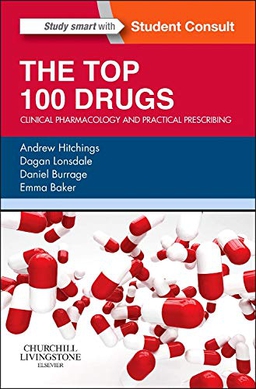The Top 100 Drugs
The Top 100 Drugs[edit | edit source]
The Top 100 Drugs is a comprehensive guide to the most commonly prescribed medications in clinical practice. It serves as an essential resource for medical students, healthcare professionals, and pharmacists, providing detailed information on the pharmacology, clinical applications, and practical prescribing of these drugs.
Overview[edit | edit source]
The book is designed to offer a concise yet thorough overview of the most frequently used medications, focusing on their mechanisms of action, therapeutic uses, side effects, and interactions. It is structured to facilitate quick reference and easy understanding, making it a valuable tool for both learning and clinical practice.
Content Structure[edit | edit source]
The content of The Top 100 Drugs is organized into sections that cover various aspects of each drug, including:
- Pharmacodynamics: This section explains how the drug works at a molecular level, detailing its mechanism of action and the physiological effects it induces.
- Pharmacokinetics: This part covers the absorption, distribution, metabolism, and excretion of the drug, providing insights into how the drug is processed in the body.
- Clinical Uses: Here, the therapeutic applications of the drug are discussed, including the conditions it is used to treat and the rationale for its use.
- Adverse Effects: This section lists potential side effects and adverse reactions associated with the drug, highlighting the importance of monitoring and managing these effects in clinical practice.
- Drug Interactions: Information on how the drug interacts with other medications, foods, or substances is provided, emphasizing the need for careful consideration when prescribing.
Educational Value[edit | edit source]
The Top 100 Drugs is particularly valuable for medical students and junior doctors as it bridges the gap between theoretical pharmacology and practical prescribing. It helps students understand the real-world application of pharmacological principles and prepares them for clinical decision-making.
Practical Prescribing[edit | edit source]
The book includes practical tips on prescribing, such as dosage recommendations, administration routes, and considerations for special populations (e.g., pediatric, geriatric, and pregnant patients). This practical focus ensures that readers are equipped with the knowledge needed to prescribe safely and effectively.
Related Pages[edit | edit source]
Search WikiMD
Ad.Tired of being Overweight? Try W8MD's physician weight loss program.
Semaglutide (Ozempic / Wegovy and Tirzepatide (Mounjaro / Zepbound) available.
Advertise on WikiMD
|
WikiMD's Wellness Encyclopedia |
| Let Food Be Thy Medicine Medicine Thy Food - Hippocrates |
Translate this page: - East Asian
中文,
日本,
한국어,
South Asian
हिन्दी,
தமிழ்,
తెలుగు,
Urdu,
ಕನ್ನಡ,
Southeast Asian
Indonesian,
Vietnamese,
Thai,
မြန်မာဘာသာ,
বাংলা
European
español,
Deutsch,
français,
Greek,
português do Brasil,
polski,
română,
русский,
Nederlands,
norsk,
svenska,
suomi,
Italian
Middle Eastern & African
عربى,
Turkish,
Persian,
Hebrew,
Afrikaans,
isiZulu,
Kiswahili,
Other
Bulgarian,
Hungarian,
Czech,
Swedish,
മലയാളം,
मराठी,
ਪੰਜਾਬੀ,
ગુજરાતી,
Portuguese,
Ukrainian
Medical Disclaimer: WikiMD is not a substitute for professional medical advice. The information on WikiMD is provided as an information resource only, may be incorrect, outdated or misleading, and is not to be used or relied on for any diagnostic or treatment purposes. Please consult your health care provider before making any healthcare decisions or for guidance about a specific medical condition. WikiMD expressly disclaims responsibility, and shall have no liability, for any damages, loss, injury, or liability whatsoever suffered as a result of your reliance on the information contained in this site. By visiting this site you agree to the foregoing terms and conditions, which may from time to time be changed or supplemented by WikiMD. If you do not agree to the foregoing terms and conditions, you should not enter or use this site. See full disclaimer.
Credits:Most images are courtesy of Wikimedia commons, and templates, categories Wikipedia, licensed under CC BY SA or similar.
Contributors: Prab R. Tumpati, MD

